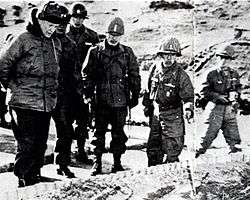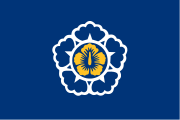Chung Il-kwon
| Chung Il-kwon | |
|---|---|
 General Chung Il-kwon | |
| Born |
November 21, 1917 Ussuriysk, Primorsky Krai, Russia |
| Died |
January 17, 1994 (aged 76) Hawaii, United States |
| Allegiance |
|
| Service/branch |
|
| Years of service | 1941-1957 |
| Rank |
Captain General |
| Battles/wars |
Second Sino-Japanese War Korean War |
| Other work | politician, cabinet minister, South Korean prime minister |
| Chung Il-kwon | |
| Hangul | 정일권 |
|---|---|
| Hanja | 丁一權 |
| Revised Romanization | Jeong Il-gwon |
| McCune–Reischauer | Chŏng Il-gwŏn |
| Pen name | |
| Hangul | 청사 |
| Hanja | 淸史 |
| Revised Romanization | Chungsa |
| McCune–Reischauer | Chungsa |
| Courtesy name | |
| Hangul | 일진 |
| Hanja | 一鎭 |
| Revised Romanization | Il-jin |
| McCune–Reischauer | IlChin |
|
Japanese name: Nakashima Ikken (中島一權) | |
Chung Il-kwon (Korean: 정일권; Hanja: 丁一權, November 21, 1917 – January 17, 1994) was a South Korean politician, diplomat and soldier. A general in the Republic of Korea Army, he served as Foreign Minister 1963 to 1964, and Prime Minister from 1964 to 1970. He was one of allies of President Park Chung-hee.
His penname was Chungsa (Korean: 청사)
Early life and education

Chung was born in Ussuriysk in Primorsky Krai, Russia, where his father worked as an interpreter for the Imperial Russian Army. After the Bolshevik Revolution of 1917, his father moved the family to Kyongwon County, North Hamgyong province in Korea. However, in 1930, the family relocated to what is now Yanbian Korean Autonomous Prefecture in Manchuria, where Chung grew up in extreme poverty. Because he was raised in Korea when it was still occupied by the Japanese, he was given the name of Ikken Nakashima.[1]
Career
Due to his excellent grades in school, Chung won a place at the Manchukuo Imperial Army academy in Mukden, from which he graduated in September 1937. Again, his performance was regarded as excellent, and he was sent on to attend the 55th class of the Imperial Japanese Army Academy in Tokyo, where he specialized in cavalry operations. He also assumed the Japanese name Nakajima Ikken (中島一權). During the Pacific War, he served in the Manchukuo Imperial Army as a military police captain. Following the Soviet invasion of Manchuria at the end of World War II, he was briefly captured by Soviet forces and interrogated by the KGB.
Chung graduated from the first class of the Korea Military Academy in 1946 and was commissioned into the South Korean army. He was in Hawaii undergoing military training at the start of the Korean War. He arrived in Korea on June 30, and was immediately promoted to major general and replaced General Chae Byeong Deok as commander of the Republic of Korea Army. Serving as a tactical commander and then major general in the Korean War, Chun Il Kwon, organized the South Korean soldiers at Inchon.[2] His initial responsibilities included regrouping the routed Korean military forces and coordinating their efforts with the United Nations command. He was the commander of all ROK forces in Pusan from July–August, which would place him at the attack of Inchon.[3] This was known for incapacitated the North Korean Army and leaving him a well-known war hero.[3] He returned to the United States for additional training in July 1951 following the National Defense Corps Incident and the Geochang massacre. However, on his return in July 1952 he was demoted by President Syngman Rhee to a divisional command and sent to a front-line combat unit. Three months later, he was promoted to deputy commander of the IX Corps (United States) commanding front line UN forces in numerous offensives and counteroffensives. Three months after this, he was again promoted to command the Korean II Corps, which he held until the end of the war.[4]
After retiring in 1957, he served as South Korea's ambassador to Turkey. In 1960, he was appointed ambassador to France, and then served as ambassador to the United States from 1960-1961 and 1962-1963. From 1963-1964 Chung served as Foreign Minister of South Korea and was Prime minister of South Korea from 1964 to 1970. During his time as an ambassador, he also took the time to study political science and international relations at prestigious universities such as Oxford and Harvard.[2]
From 1971, Chung served as a member of the National Assembly from the Democratic Republican Party for three consecutive terms. He also served as chairman in the ninth National Assembly of 1973-1979.
In March 1991, Chung received treatment for lymph cancer in Hawaii. Although he continued political activities in 1992 for the Democratic Republican Party in 1993, particularly in support of Kim Young-sam during the 1992 Korean presidential election, he was re-hospitalized in Hawaii in January 1994 due to cancer, and died there. He received a state funeral and was buried at the Seoul National Cemetery. Survived by his four children and his wife, Park Hye-Soo, after his death in Hawaii.[2]
Works
- War and Ceasefire (전쟁과 휴전)
- Chung Il-kwon's Memoir (정일권 회고록, 丁一權 回顧綠)
See also
References
- ↑ "Chung Il-kwon". WW2DB. Retrieved 2015-11-09.
- 1 2 3 Lyons, Richard D. (1994-01-19). "Chung Il Kwon, Korean General And Premier, 76". The New York Times. ISSN 0362-4331. Retrieved 2015-11-09.
- 1 2 "Chung Il Kwon | biography - Korean army officer and politician". Encyclopedia Britannica. Retrieved 2015-11-09.
- ↑ Varhola, Michael J (2000). Fire and Ice: The Korean War, 1950-1953. Da Capo Press. ISBN 1882810449. page 205
External links
- Chung Il-kwon (Korean)
- Chung Il-kwon (Korean)
- list of Prime ministrer of South Korea (Korean)
- Chung Il-kwon (Korean)
- 역대 주미 대사관 대사 (Korean)
| Political offices | ||
|---|---|---|
| Preceded by Choi Du-sun |
Prime Minister of South Korea 1964 - 1970 |
Succeeded by Baek Du-jin |
| Preceded by Yang Yu-chan |
Republic of Korea Ambassador to USA 1960 - 1961 |
Succeeded by Chang Li-wook |
| Preceded by Chang Li-wook |
Republic of Korea Ambassador to USA 1962 - 1963 |
Succeeded by Kim Jeong-ryul |
| Preceded by Kim Yong-sik |
Foreign minister of South Korea 1963 - 1964 |
Succeeded by Lee Dong-won |
| Preceded by Lee Dong-won |
Foreign minister of South Korea 1966 - 1967 |
Succeeded by Choi Kyu-hah |

